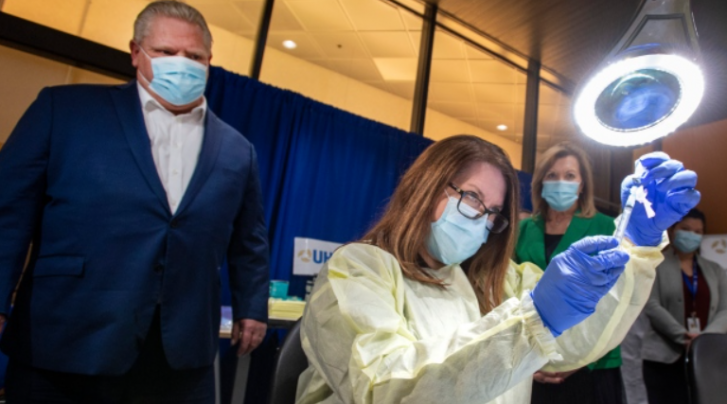This post is also available in: 简体中文 繁體中文
The Ford government says that it expects to administer the first dose of COVID-19 vaccines to all Ontarians over the age of 60 by the end of May, a full two months ahead of schedule.
Premier Doug Ford, along with Health Minister Christine Elliott, Solicitor General Sylvia Jones, Dr. David Williams, chief medical officer of health and retired Gen. Rick Hillier, chair of Ontario’s COVID-19 vaccination task force, provided an update on Phase Two of the rollout plan Friday afternoon.
Phase Two is scheduled to start in April and run until July. The government says approximately 9 million Ontarians are expected to receive their first dose of an approved vaccine during this time.

Ontarians aged 60 to 79 years old are placed at the top of the prioritization ladder in Phase Two, representing 2.5 million people. The government says it expects to administer the first dose to all Ontarians over the age of 60 by the end of May.
“In this last three to five days, we’ve had a seismic shift in our vaccination opportunities and in our program to roll it out,” Hillier said.
Seniors will continue to receive the Pfizer-BioNtech and Moderna vaccines while those under 64 will start receiving the newly approved AstraZeneca vaccine as early as next week.
As for required second doses, the government announced that it will delay the time interval between the first and second doses from roughly three weeks to four months starting on Mar. 10.
The National Advisory Committee on Immunization has recommended extending the vaccination dose interval for all Health Canada approved vaccines, while still maintaining effective immunization against the disease.
On Friday, Health Canada announced that Johnson & Johnson’s COVID-19 vaccine has received the green light for use across the country. This vaccine only requires one dose for full immunization.
Next in line to receive the vaccine in Phase Two are individuals in the at-risk category which is further broken down into three levels: those with health conditions and in congregate settings, those in specific hot spot zones, and workers who cannot work from home. This entire group represents roughly 6.5 million people across the province.
The government provided a list of these at-risk individuals based on those considered highest-risk, high-risk and at-risk. The highest-risk category includes organ transplant recipients and those with kidney disease, while the at-risk category includes those with dementia, diabetes and liver disease.
Phase Two will also target hot spots in all of Ontario’s 34 public health units across the province.
But the government says 13 public health units will receive up to a total of 920,000 additional doses to target historic and ongoing hot spots with high rates of death, hospitalization, and transmission. The hot spots include Toronto, York, Peel, Durham, Halton, Hamilton, Niagara, Ottawa, Simcoe Muskoka, Waterloo, Wellington Dufferin Guelph, Windsor Essex and South West.
20210306vaccine-update_tech-briefing-finalArticle From: CP24 news
Author:Kerrisa Wilson

